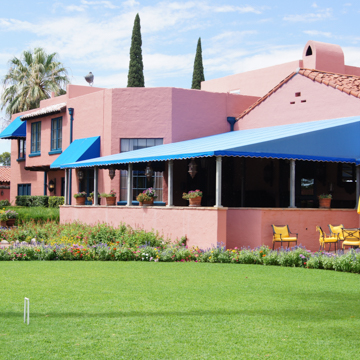Constructed in 1930, Tucson’s Arizona Inn is a one of few extant examples of the resort hotels that were popular in Arizona in the early twentieth century. One of the oldest such hotels in continuous operation, the Inn remains an embodiment of the western hospitality and the state’s early tourism industry. Isabella Greenway (1886–1953) was the force behind the hotel’s founding and success.
In 1932, a few years after the Inn’s establishment, the New York Times described Greenway as “the most talked-of woman at the National Democratic Convention” (she seconded the nomination of Franklin Delano Roosevelt for president). A close friend of the Roosevelt family, Greenway was a bridesmaid at the wedding of Franklin and Eleanor. In 1933, she became the first woman to represent Arizona in the U.S. Congress when she won a special election to fill the vacated seat of the state’s only member of the House of Representatives. A year later, she was reelected to a full second term. An entrepreneur, businesswoman, and social activist, Greenway launched an airline, established a cattle ranch, created occupational therapy programs for returning war veterans, and built the gracious Arizona Inn.
During the early twentieth century, the Tucson region had become a popular destination for tourism and health-oriented resorts. By the late 1920s, demand for resort destinations outpaced supply in Arizona. In response to the demand and a desire to provide employment for local veterans of World War I, Greenway purchased fourteen acres of land on the outskirts of Tucson as the site of a resort hotel. Construction began in 1930 and by the start of the winter season at the end of that year, the hotel included ten buildings. Another ten buildings, along with a swimming pool and lush landscaping, were completed by the end of 1937. Former desert ranchland was utterly transformed into a home-like resort with lush outdoor spaces and inviting landscapes where hotel guests could relax in Arizona’s arid and sunny climate.
Although Greenway hired Merritt H. Starkweather as her architect, she was personally involved in the selection of every element of the Mediterranean and Spanish Colonial Revival–style Arizona Inn. This extended to the furnishings: the hotel showcased furniture made by veteran employees of Greenway’s Arizona Hut furniture workshop. (Greenway's interest in veteran’s issues stemmed in part from her late husband, John Greenway, who was a Brigadier General in the U.S. Army.)
The complex of buildings includes casita-style rooms and suites, dining and recreational facilities, and seven distinct landscape areas. Greenway’s and Starkweather’s attention to detail manifested itself in the final design, color, and layout of the hotel site. The buildings were laid out to create interior courtyard spaces using undulating wall heights, differing roof forms, and projecting horizontal and vertical surfaces that together create a village-like appearance. Unifying the entire complex is the bright pink stucco, blue trim, and red clay tile roofs. From the orientation of the individual buildings to create interior, protected communal spaces and courtyards, to the borrowing of ideas from Spanish gardens, to choosing specific plantings to provide shade and privacy, Greenway’s attention to detail was echoed in the motto of her business—a place of privacy and tranquility.
Although Starkweather is mostly known for his civic buildings, during the 1930s he was the supervising architect for lavish residences in Tucson’s exclusive El Encanto neighborhood; one of his designs for that subdivision was a striking Art Moderne–inspired Pueblo Revival house. Starkweather was responsible for introducing this architectural hybrid, known locally as “Pueblo Deco,” into Tucson’s vernacular. Starkweather helped create the Arizona chapter of the American Institute of Architects and was named a fellow of the AIA in the 1960s.
References
Miller, Kristie. Isabella Greenway: An Enterprising Woman. Tucson: University of Arizona Press, 2004.
Nequette, Anne M., and R. Brooks Jeffery. A Guide to Tucson Architecture. Tucson: University of Arizona Press, 2002.
Chorover, Gina, Levstik, Jennifer, and Helen Erickson. Historic American Landscape Survey of the Arizona Inn. Tucson: University of Arizona Heritage Conservation program, Spring 2013.

